ПОИСК:
References to Photos.
1. Review and thematic excursions at the museum are conducted by the students of the historical faculty.
N. Vasilchenko is an excursion guide.
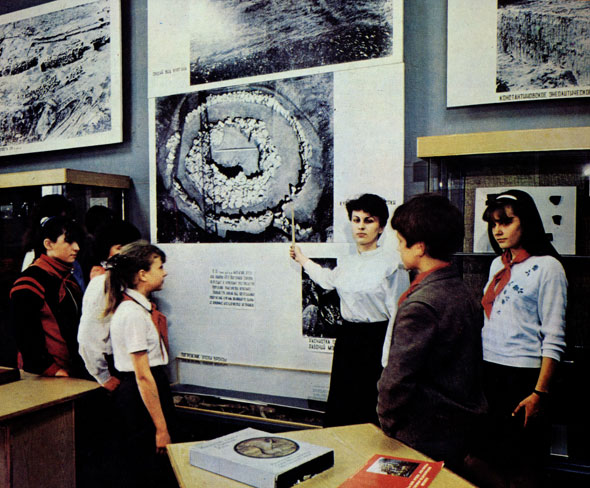
Обзорные и тематические экскурсии по музею проводят студенты исторического факультета 1. Ведет экскурсию Н. Васильченко
2. Hand chisel - the universal implement of the early Palaeolithic age/the experimental sample made by A. Matyukhin - a scientific worker of the Academy of Sciences of the USSR, Leningrad Regional Institute of Archaeology.
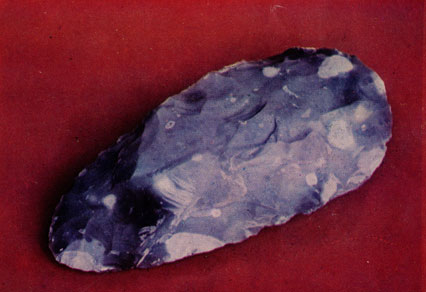
Ручное рубило - универсальное орудие раннего палеолита. 2. Реплику изготовил научный сотрудник ЛОИА АН СССР А. Матюхин. Орудия труда и украшения энеолита - ранней бронзы
3. The implements of labour and decorations of the Pit Culture. Knives made of bronze and flint, ivory catapults, the necklace made of shell folds of the river mollusc.
Early Bronze Age. The end of the 3d - the beginning of the 2nd millenia В. С.
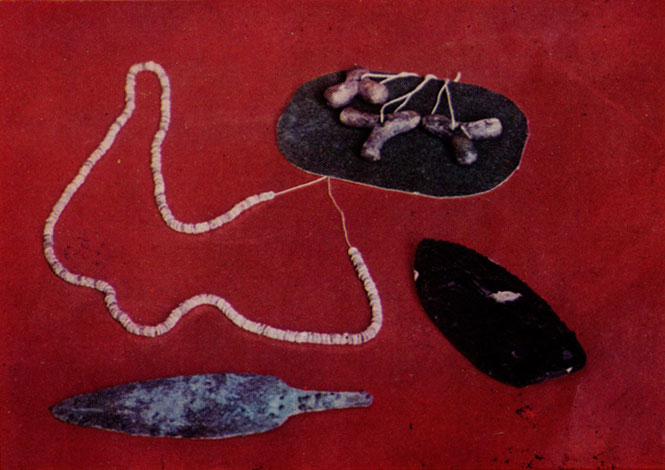
3. Бронзовый и кремневый ножи, костяные рогатки, ожерелье из створок речного моллюска. Ямная культура. Константиновский р-он
4. The ceramics of the catacomb culture is marked by its careful decoration and rich ornamentation.
Middle bronze age.
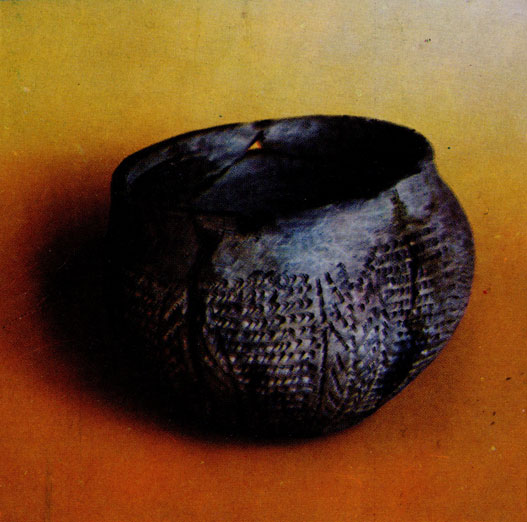
4. Керамика эпохи средней бронзы отличается тщательной отделкой и пышной орнаментацией. Сосуд катакомбной культуры. Константиновский р-он
5. The hatchet-hammer and the top of the mace made of the Caucasian mineral are a symbol of power and a formidable weapon in the hands of a nomad.
The Catacomb Culture.
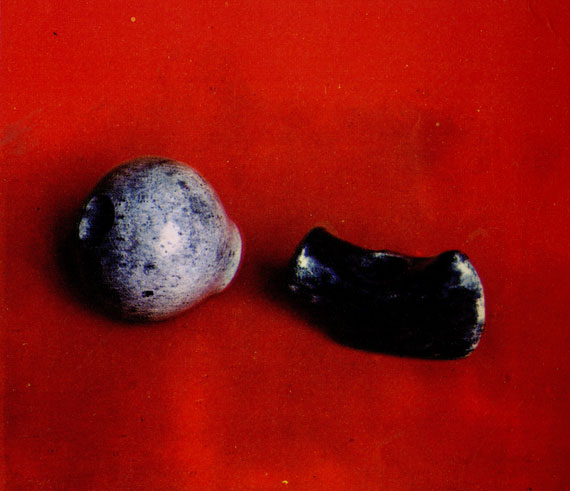
5. Символы власти: топор-молоток и навершие булавы. Змеевик. Катакомбная культура. Константиновский р-он
6. The necklace made of tubular bones of birds and teeth capsules of fossil fish.
The Catacomb Culture.

6. Ожерелье из костей птиц и капсул зубов ископаемой рыбы. Катакомбная культура. Константиновский р-он
7. Labour implements made of stone continue to compete with bronze ones up to the mastering of iron by the man. Bronze knife/catacomb culture/, tip of a spear made of flint/the felling culture (srubovaya)/
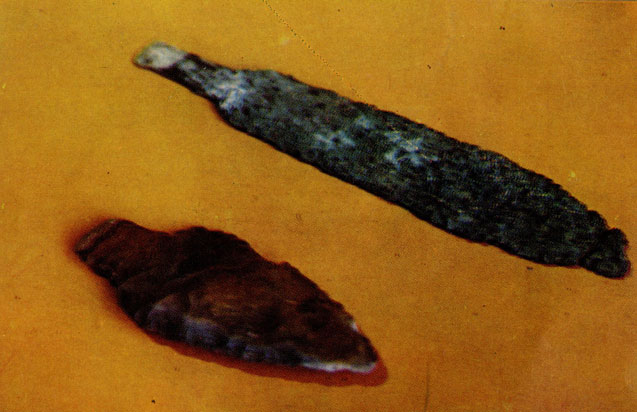
Каменные орудия, вплоть до освоения человеком железа, применяются наряду с металлическими. 7. Бронзовый нож, катакомбная культура. Кремневый наконечник копья, срубная культура. Константиновский р-он
8. The tree of peace - the object of worship of ancient Indo-Europeans. The vessel with the imprint of the tree of peace. Late Bronze Age.
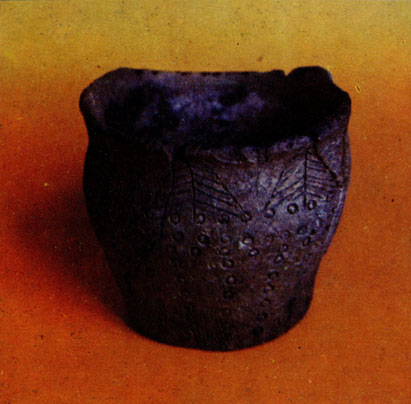
Орнамент, зачастую, отражает мир сложных космогонических представлений носителей древних культур. 8. Сосуд с орнаментом. Эпоха поздней бронзы. Красносулинский р-он
9. Labour implements and decorations from the late Bronze age burial: an ivory buckle, a bronze adze/a kind of an axe), a knife and a ring. «An arrow without a miss, an untiring horse and a short sword-arkinak...»- are the attributes of a Scythian warrior.

9. Костяная пряжка, бронзовые тесло-топор, нож и перстень. Эпоха поздней бронзы. Красносулинский р-он
10. Scythian Arrow-heads. Bronze.
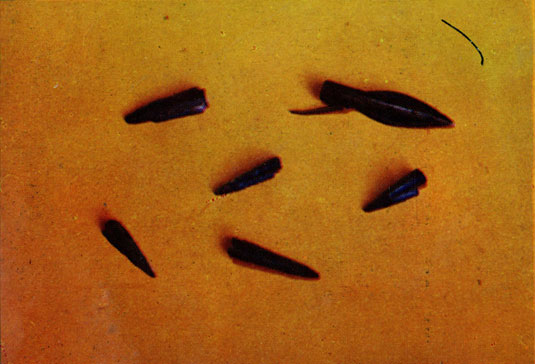
10. Наконечники скифских стрел. Бронза. Ранний железный век. Елизаветовский могильник
11. Sword-arkinak, knife and bit. VI-IV В. С.
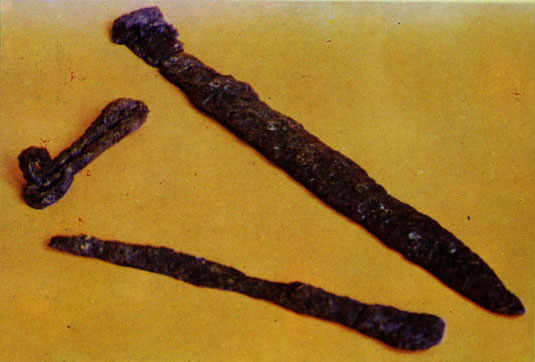
11. Меч-акинак, нож, удила. Железо. Дельта Дона
12. Exposition. «Early Iron Age», central part.
Above - Upholstery of a gorit with the scenes from the myths about Achilles. Below - Scabbard. Antique amphora.
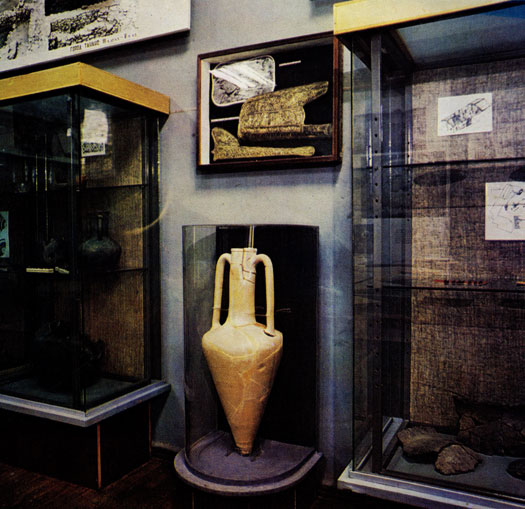
Экспозиция 'Ранний железный век', центральная часть. 12. Золотая обивка ножен меча и горита со сценами из мифа об Ахилле. Гальванокопия. Вверху. Хиосская амфора. Внизу
13. A fragment of the neck of an amphora with a brand.
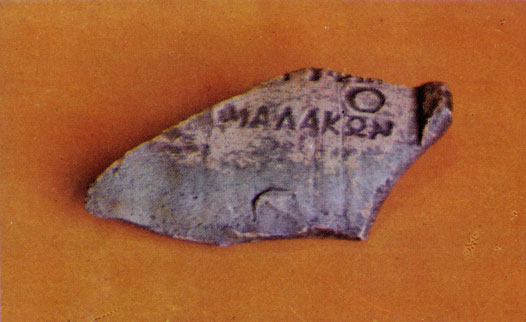
13. Клеймо на горле Гераклейской амфоры. Фрагмент. Дельта Дона
14. Glass beads - the most popular kind of decoration.

. Бусы-самый массовый вид украшений. Елизаветовский могильник
15. Bronze bracelets and a toilet suit.

15. Браслеты и туалетный прибор. Бронза. Дельта Дона
16. A Ritual stone dish, a censer, a hand-spinning device. The Sarmatians.
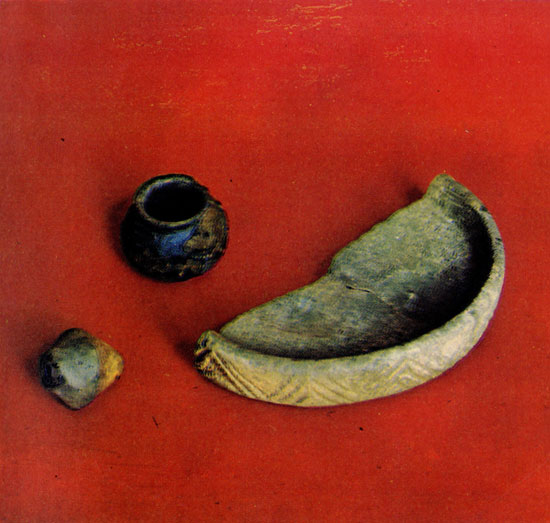
16. Ритуальное каменное блюдо, курильница и пряслице. Савроматы-сарматы. Константиновский р-он
17. The Sarmatian riveted copper. Bronze.
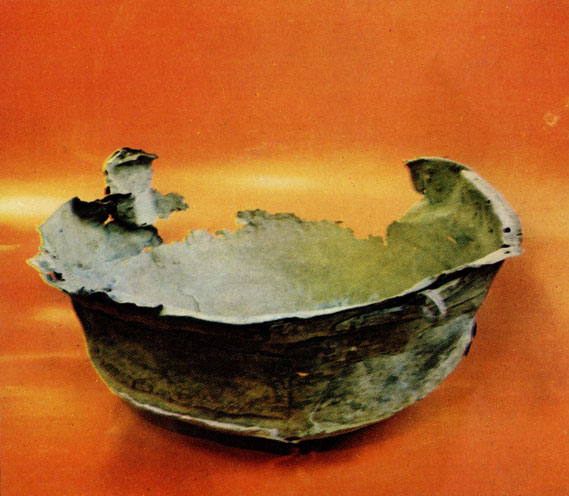
17. Сарматский клепаный котел. Бронза. Багаевский р-он
18. The Sarmatian dagger and bit.
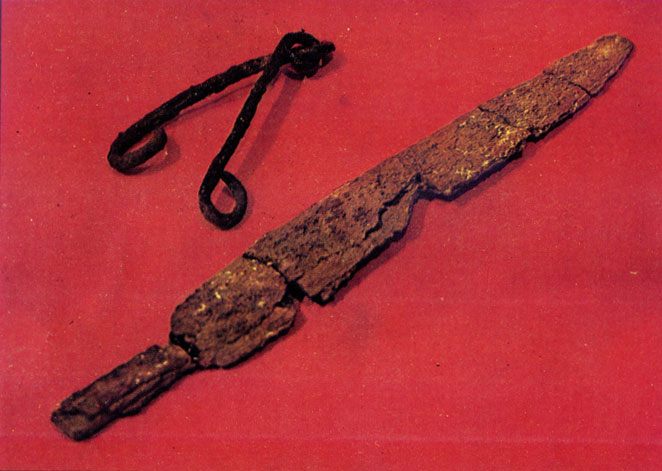
18. Сарматский кинжал и удила. Константиновский р-он
19. Tanais is the largest greek-barbarian commercial and economic centre. Burnt wheat grains, glass slags, a handning device, weaver's plummet, fish scales. The fragment of a «Megar» cup.

Танаис-крупнейший греко-варварский торговый и экономический центр. 19. Обгоревшие зерна пшеницы, стеклянные шлаки, пряслице, ткацкое грузило, чешуя рыб, фрагмент 'мегарской' чаши
20. The invasion of the Huns led to ousting of the Iranian language speaking population by the Turkish language speaking one.
Iron and bronze claspers. Early Middle Ages.

Нашествие гуннов привело к вытеснению ираноязычного населения тюркоязычным.
21. A dagger and bit, quiver hook and arrow-heads. Early Middle Ages.
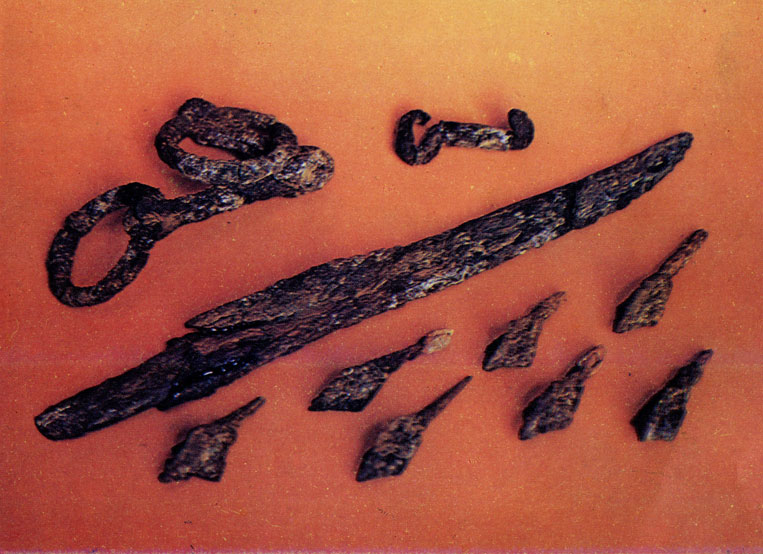
21. Кинжал, удила, колчанный крючок и наконечники стрел. Раннее средневековье
22. A horse occupied a very important place in the life and the faith of the people of Hazar Settlement. A Brick with a horse on it, archaeological excavations of the Rostov State University laboratory.
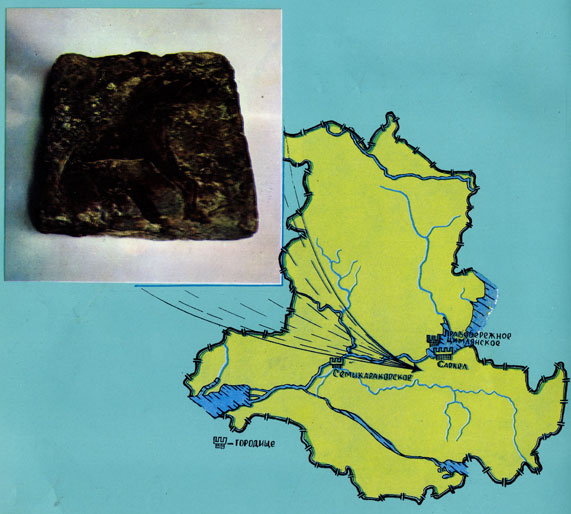
Конь занимал значительное место в жизни и верованиях населения Хазарского каганата. 22. Кирпич с изображением коня
23. The exposition «Nomads of the developed Middle Age» is presented with the weapon of a polovets warrior and the equipment of the battle horse: a helmet, a metal shirt, a sabre, a unique in its safety birch-tree-bark arrow-holder with lacy plates, a cauldron, a bit and a rider's stirrups. Archaeological excavations of the Rostov State University laboratory.

Экспозиция 'Кочевники развитого средневековья' представлена вооружением половецкого воина и снаряжением коня. 23. Шлем, кольчуга, сабля, берестяной колчан с ажурными костяными накладками, удила, стремена и котел. Цимлянский, Мартыновский р-оны
24. The Gold Ord town of Azak and the Genoese trading station Tana - a big commercial and economic centre and the cross-road on the way from Western Europe to Persia, India, China.
An amphora, a spherical cone, a ceramic cast.
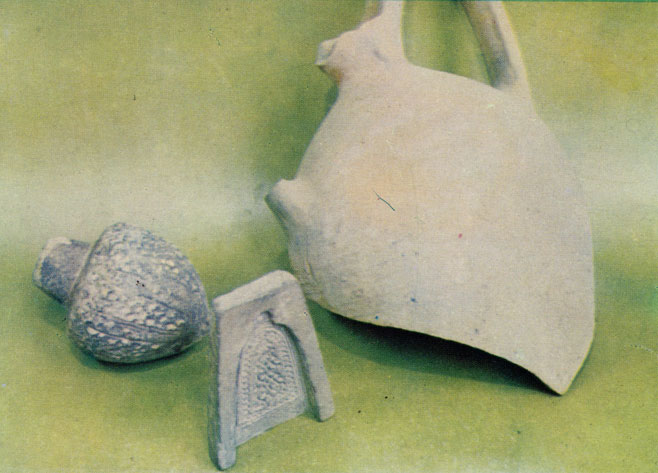
Золотоордынский город Азак и генуэзская фактория Тана - крупный торговый, экономический центр и перевалочный пункт на пути из Западной Европы в Персию, Индию, Китай. 24. Амфора, форма, г. Азов
25. The complicated processes which were taking place in the steppes had finished by the XVI century resulting in the formation of the Cossaks. Ceramic vessels and a horn powderflask.
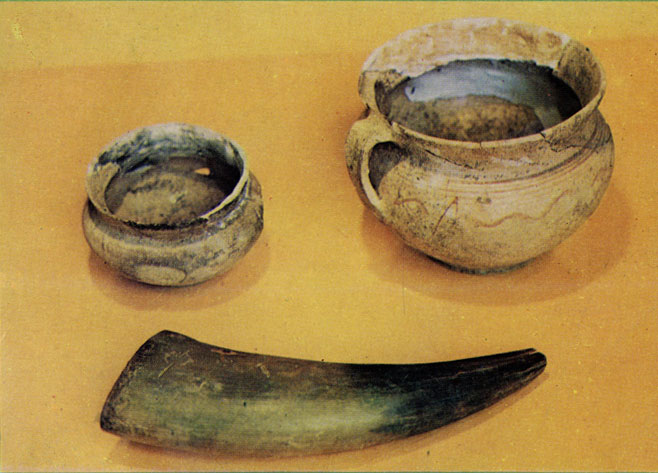
Сложные процессы, протекавшие в степи, завершились к XVI в. образованием казачества. 25. Керамические сосуды и роговая пороховница. Константиновский р-он
26. Creative cooperation of the museums promotes more effective usage of the unique exhibits. The fragment of the exposition in the Rostov Local Lore Museum with the materials from the funds of the educational museum of the Rostov State Teachers' Training Institute.

Творческое сотрудничество музеев способствует более эффективному использованию редких экспонатов. 26. Фрагмент экспозиции в Ростовском областном краеведческом музее с использованием материалов из фондов музея РГПИ
27. How fascinating, attractive and far away the world of our forefathers is. The lecture on the subject is being delivered by the director of the museum A. Smolyak.
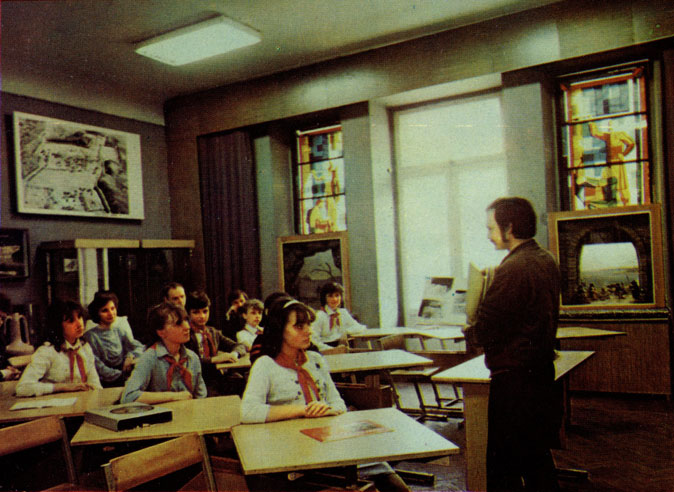
Как увлекателен, заманчив и далек от нас мир предков. 27. Тематическую лекцию для учащихся проводит заведующий музеем А. Смоляк
28. The Archaeological Society members of the Don Young Researchers Academy are the desired guests and good helpmates.
M. Shcheglov, D. Sherstyukov, A. Sherstyukova, O. Dmit-riev are restoring ceramics.

Ребята археологической секции Донской Академии Юных исследователей - желанные гости и хорошие помощники. 28. За реставрацией керамики: М. Щеглов, А. Шерстюков, А. Шерстюкова, Д. Дмитриев
29. Practical classes and seminars are conducted in the museum. Lecturer of the General/Universal/History chair A. Gamayunov is conducting practical classes.

Практические занятия в музее позволяют создать правильное и наиболее яркое представление о материальной и духовной культуре населения региона в конкретно-историческую эпоху. 29. Ведет занятие асс. кафедры всеобщей истории А. Гамаюнов
30. Students' and regional scientific conferences are held on the basis of the museum.
In the photo: Regional scientific conference: «International connections in the Black Sea basin in ancient and middle centuries». In presidium: V. Korolyov - assistant-professor of the History sources study department of the Rostov University; A. Kozhanov - assistant-professor, Dean of the History Faculty.
The Conference is opened by A. Starostin, prorector for scientific work of the Rostov Teachers' Training Institute.
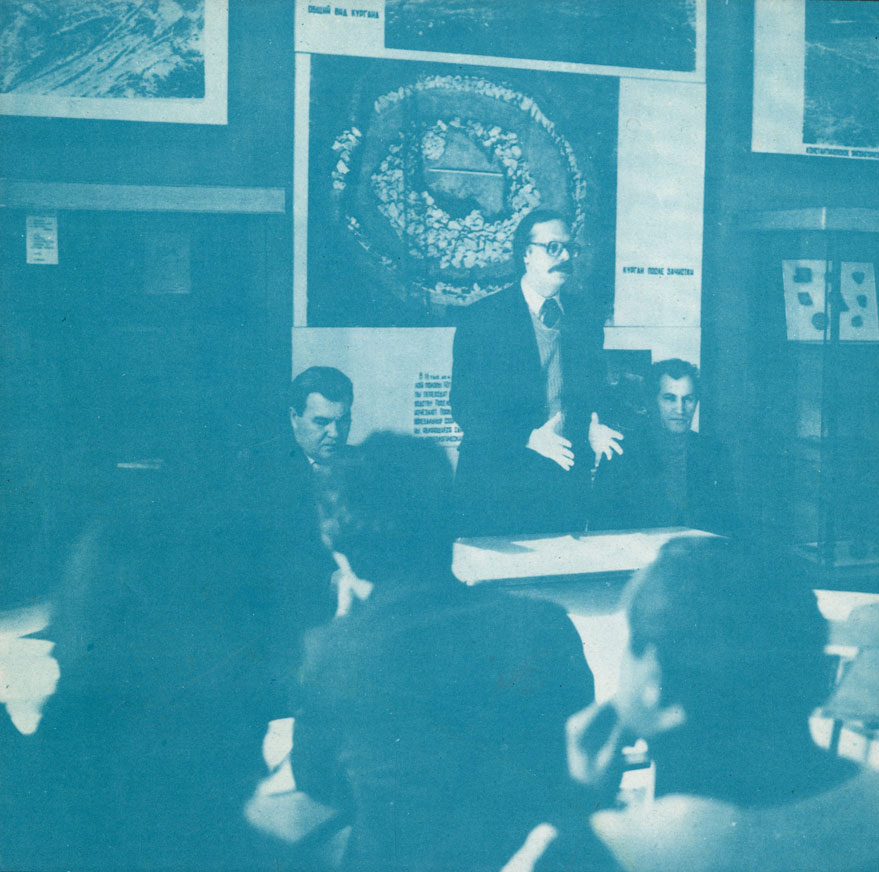
30. Региональная научная конференция 'Международные отношения в бассейне Черного моря в древности и средние века'. В президиуме: В. Королев - доцент кафедры источниковедения и вспомогательных исторических дисциплин РГУ, А. Кожанов - доцент, декан исторического факультета РГПИ; открывает конференцию А. Старостин - доцент, проректор по научной работе РГПИ
31. It has become a good tradition to hold photo-exhibitions devoted to the International Day of Children in the town's park named after M. Gorky. Original exhibits always attract the visitors'- special attention.
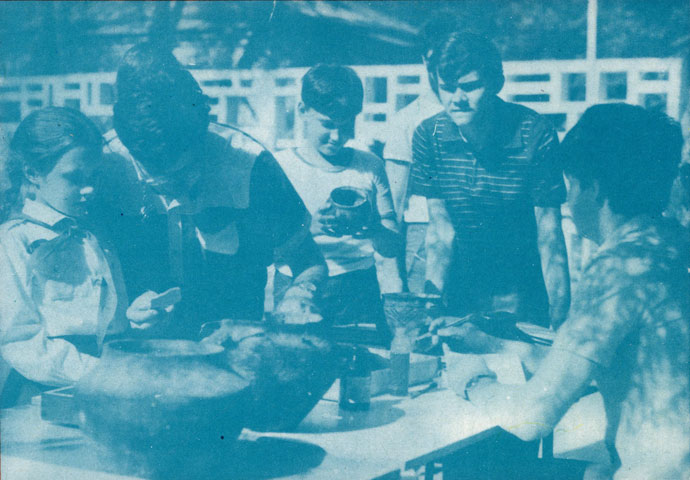
31. Хорошей традицией для музея стало ежегодное проведение фотовыставок в городском парке им. Горького, приуроченных к Международному дню защиты детей. Особое внимание всегда привлекают подлинные экспонаты. Музей ведет работу по выявлению и исследованию разрушающихся памятников археологии
32. The museum's activity comprises work in revealing and studing ruined archeological monuments.
In the photo: G. Perelygin, a student of the History Faculty and students of the Don Young Researchers Academy I. Yakovenko, A. Maslovsky, G. Ilchenko, A. Bikadorov are clearing a ruined burial.
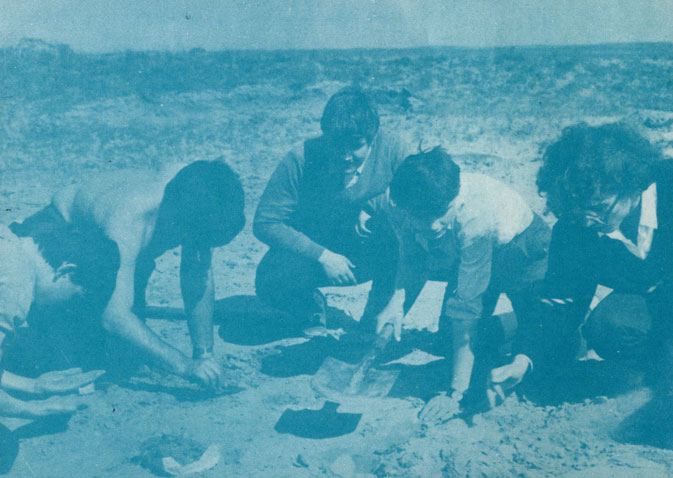
32. Бережно очищают находку студент исторического факультета Г. Перелыгин и члены ДАНЮИ А. Быкадоров, Г. Ильченко, А. Масловский, И. Яковенко
|
|
© HISTORIC.RU 2001–2023
При использовании материалов проекта обязательна установка активной ссылки:
http://historic.ru/ 'Всемирная история'
При использовании материалов проекта обязательна установка активной ссылки:
http://historic.ru/ 'Всемирная история'